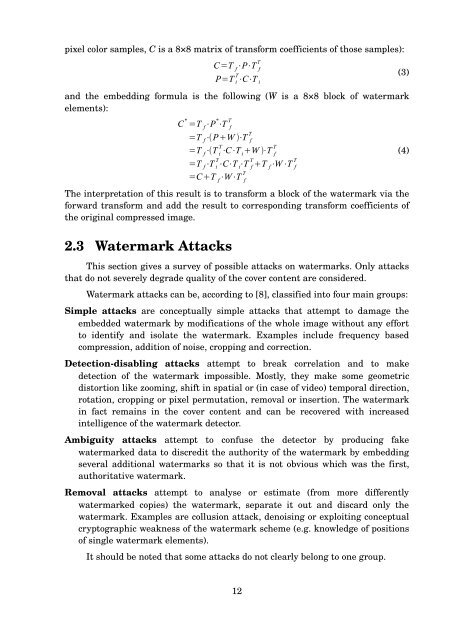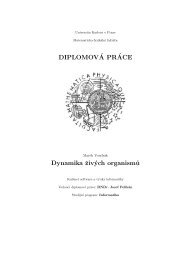MASTER THESIS Video Watermarking - Computer Graphics Group ...
MASTER THESIS Video Watermarking - Computer Graphics Group ...
MASTER THESIS Video Watermarking - Computer Graphics Group ...
Create successful ePaper yourself
Turn your PDF publications into a flip-book with our unique Google optimized e-Paper software.
pixel color samples, C is a 8×8 matrix of transform coefficients of those samples):<br />
and the embedding formula is the following (W is a 8×8 block of watermark<br />
elements):<br />
The interpretation of this result is to transform a block of the watermark via the<br />
forward transform and add the result to corresponding transform coefficients of<br />
the original compressed image.<br />
2.3 Watermark Attacks<br />
<br />
<br />
<br />
<br />
<br />
<br />
<br />
<br />
<br />
<br />
<br />
<br />
<br />
<br />
This section gives a survey of possible attacks on watermarks. Only attacks<br />
that do not severely degrade quality of the cover content are considered.<br />
Watermark attacks can be, according to [8], classified into four main groups:<br />
Simple attacks are conceptually simple attacks that attempt to damage the<br />
embedded watermark by modifications of the whole image without any effort<br />
to identify and isolate the watermark. Examples include frequency based<br />
compression, addition of noise, cropping and correction.<br />
Detection-disabling attacks attempt to break correlation and to make<br />
detection of the watermark impossible. Mostly, they make some geometric<br />
distortion like zooming, shift in spatial or (in case of video) temporal direction,<br />
rotation, cropping or pixel permutation, removal or insertion. The watermark<br />
in fact remains in the cover content and can be recovered with increased<br />
intelligence of the watermark detector.<br />
Ambiguity attacks attempt to confuse the detector by producing fake<br />
watermarked data to discredit the authority of the watermark by embedding<br />
several additional watermarks so that it is not obvious which was the first,<br />
authoritative watermark.<br />
Removal attacks attempt to analyse or estimate (from more differently<br />
watermarked copies) the watermark, separate it out and discard only the<br />
watermark. Examples are collusion attack, denoising or exploiting conceptual<br />
cryptographic weakness of the watermark scheme (e.g. knowledge of positions<br />
of single watermark elements).<br />
It should be noted that some attacks do not clearly belong to one group.<br />
12<br />
(3)<br />
(4)
















